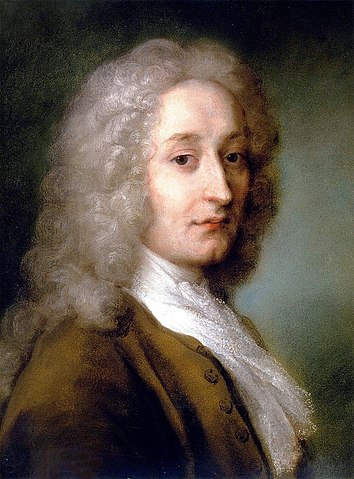
Born: 10 October 1684
Died: 18 July 1721 (aged 36)
Period: Rococo
The Life of Antoine Watteau
Antoine Watteau, born on October 10, 1684, in Valenciennes, France, was a pivotal figure in the Rococo movement, known for his delicate paintings that capture the essence of French society during the early 18th century. His work is characterized by its fluidity, elegance, and the subtle interplay of light and color, which together create a sense of ephemeral beauty and fleeting moments of pleasure.
Watteau’s early life was marked by modest beginnings, and he moved to Paris in his late teens, where he initially struggled to find patronage. He worked in various workshops, including that of Claude Gillot, which greatly influenced his developing style. Gillot’s theatrical scenes and interest in the commedia dell’arte left a lasting impression on Watteau. Later, Watteau also worked with the decorator Claude Audran III, who introduced him to the luxuriant Rococo style and the use of decorative motifs, which became prominent in his later works.
Watteau is best known for inventing the genre of fêtes galantes: elegant outdoor gatherings of stylish men and women engaged in conversation, music, dance, or love courtship, set against idyllic landscapes. These scenes, while seemingly casual, are meticulously composed, reflecting Watteau’s keen observation of social interactions and his ability to convey nuanced expressions and emotions.
In 1717, Watteau’s submission of “Pilgrimage to Cythera” to the Royal Academy of Painting and Sculpture earned him immediate acceptance and the creation of a new category for his genre of painting. Despite this recognition, Watteau remained a somewhat solitary figure, plagued by poor health throughout his life.
Watteau’s influence extended beyond his fêtes galantes; he was also a master of portraiture and theatrical scenes, as well as an accomplished draftsman. His drawings, characterized by their spontaneity and sensitivity, were highly regarded by contemporaries and have continued to be celebrated for their technical skill and emotional depth.
Antoine Watteau died on July 18, 1721, at the young age of 36. His career was brief, but his legacy is enduring. He left behind a body of work that profoundly influenced the Rococo movement and subsequent generations of artists. Watteau’s paintings capture the spirit of an era that valued beauty, elegance, and the pleasures of life, making him one of the most important figures in French art history.
Antoine Watteau’s Notable Works
Antoine Watteau’s oeuvre, celebrated for its lyrical beauty and delicate portrayal of the Rococo era, offers a fascinating glimpse into the aristocratic and pastoral pleasures of 18th-century France. Here are ten of his most famous works that encapsulate his mastery:
- Pilgrimage to Cythera (1717) – Often considered Watteau’s masterpiece, this work epitomizes the fête galante genre, depicting elegantly dressed couples embarking on a journey to the mythical island of Cythera, the birthplace of Venus, symbolizing love and beauty.
- Gilles (circa 1718-1719) – This poignant solitary figure, possibly a portrait of a commedia dell’arte actor, stands out for its introspective quality and has been interpreted as Watteau’s alter ego.
- The Embarkation for Cythera (1717) – A variation of his masterpiece, showcasing a dreamy departure scene that is rich in allegorical meaning, centered around themes of love and desire.
- L’Enseigne de Gersaint (1720) – Watteau’s last great work, a shop sign for the art dealer Gersaint, ingeniously captures the commercial and cultural milieu of Paris, highlighting the transient nature of beauty and art.
- The Italian Comedians (1720) – This vibrant painting depicts actors from the commedia dell’arte, emphasizing Watteau’s fascination with the theater and his ability to capture the vitality of performance.
- The Music Party (circa 1718) – A quintessential fête galante scene that elegantly portrays a group of aristocrats enjoying music in a lush garden, showcasing Watteau’s skill in depicting leisurely and intimate moments.
- The Love Song (circa 1716-1717) – A tender depiction of a couple in a secluded garden, with the man playing a guitar, emblematic of Watteau’s interest in themes of courtship and the idyllic nature of love.
- Mezzetin (circa 1718-1720) – A captivating portrayal of the commedia dell’arte character Mezzetin, absorbed in playing the guitar, highlighting Watteau’s empathy for his subjects and his nuanced understanding of human emotion.
- The Shepherds (circa 1716-1718) – Also known as “Pastoral Gathering,” this work depicts a serene moment in a pastoral setting, reflecting Watteau’s idealization of rural life and his mastery of landscape painting.
- Pierrot (formerly known as Gilles) (circa 1718-1719) – Another depiction of the commedia dell’arte character, showcasing Watteau’s ability to convey complex emotions through the subtlety of posture and expression.
Watteau’s paintings are celebrated for their ethereal quality and the sense of fleeting moments they capture, embodying the Rococo spirit with their emphasis on pleasure, love, and the beauty of nature. His innovative compositions and delicate use of color have left a lasting impact on the world of art.